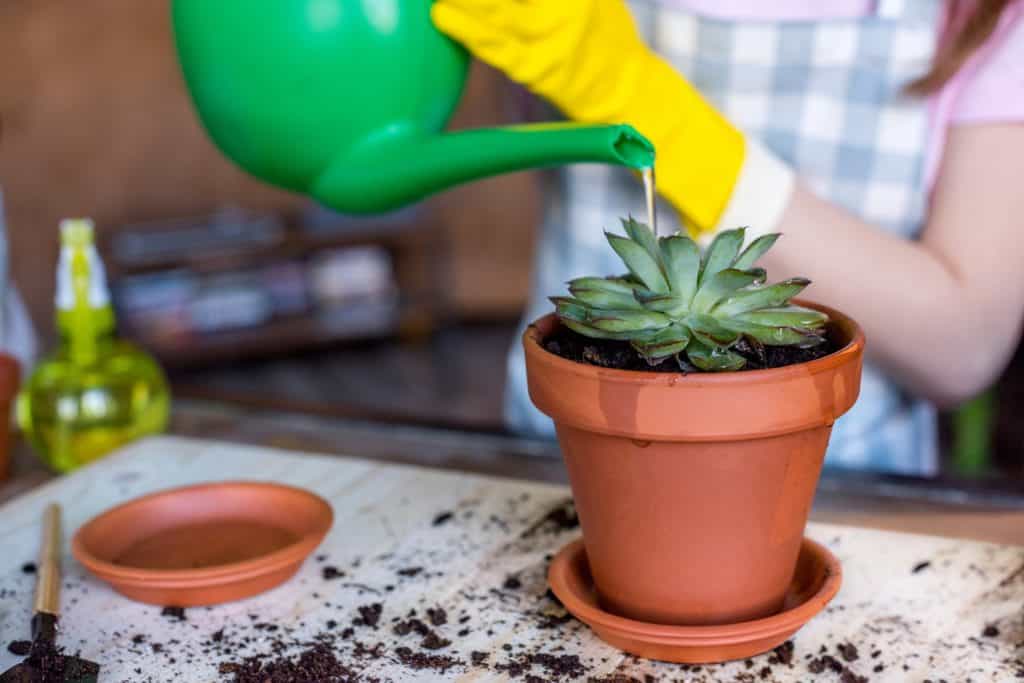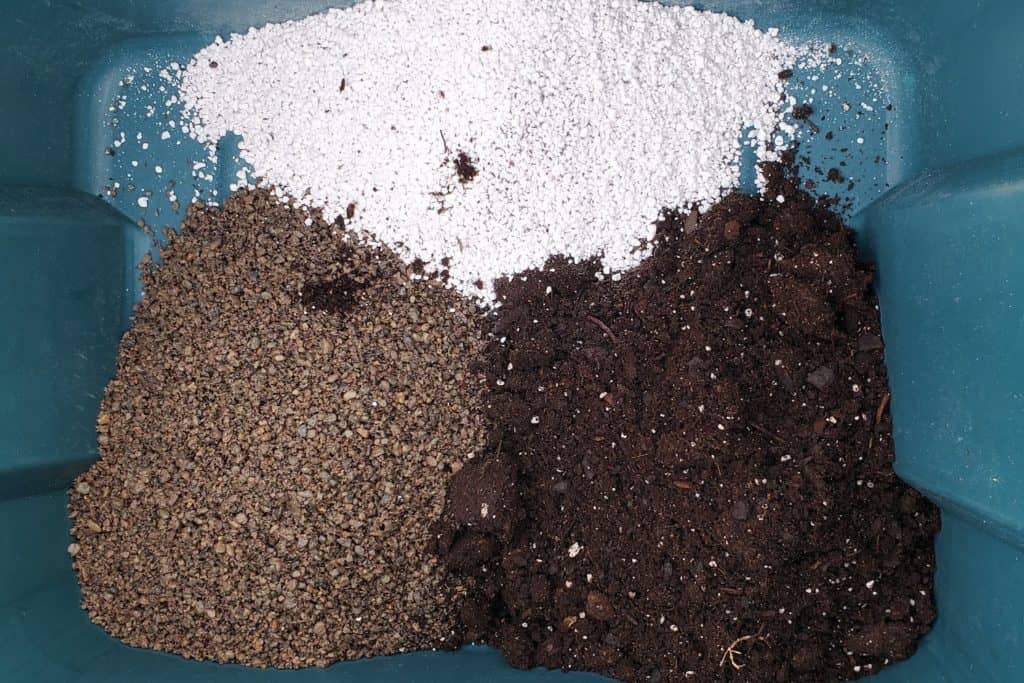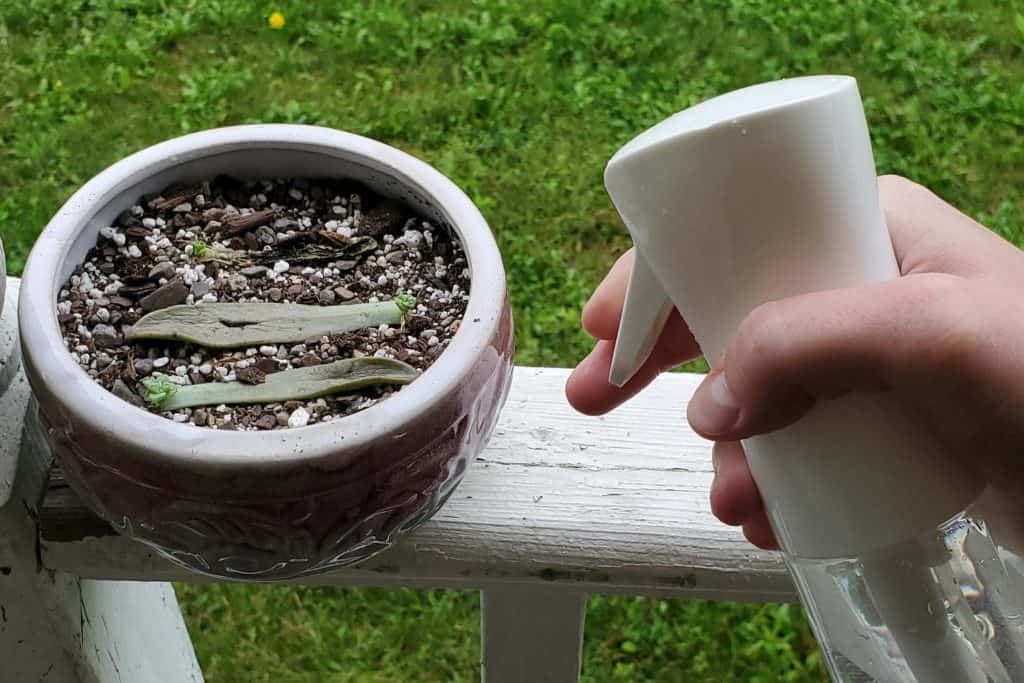How to Water Succulents (a Complete Guide)
I absolutely love shopping online for succulents and gardening supplies. If you aren't already saving money by comparing prices online, give it a try! Here are six of my favorite things that I have purchased online as I build my own succulent oasis:
Watering succulents downright scared me. One source said I should mist them, another said I should drench them, and others told me to just ignore my succulents completely!
While each one of those methods has its time and place, I needed to learn how to water succulents the right way, during the different stages of their lives.
Did you know that proper watering is one of the most essential aspects of succulent care? Once you’ve got their moisture needs down, growing these fleshy houseplants is a breeze!
Whether you’ve just bought your first succulents and are wondering what care they need, or you’re a succulent serial killer wondering where things keep going wrong: I’m going to tell you everything you need to know about watering succulents.
When to Water Succulents
Keep in mind, it’s important to let you know that I – unfortunately – can’t just give you a schedule that says when to water your succulent. It would be nice if it was that simple!
What I can tell you is that they need a drink when their soil is fully dry. How quickly that happens depends on a number of different factors, including:
- species
- season
- light levels
- pot material
- soil type
- air humidity
- etc.
Because a succulent’s watering needs changes with the environment and even the season, watering on a strict schedule can cause you to accidentally over- or underdo it. It’s a much better idea to learn to gauge your plant’s thirst levels using sight and touch.
Your succulents may need water as often as twice a week (or more!) or as little as once a month. Don’t plan succulent waterings based on time, but go by soil moisture level instead.
Take a look at some general guidelines for watering indoor and outdoor succulents according to the seasons. This will help you get an idea of what you can expect.
Watering Succulents During Growing Season
While most succulents grow during spring and summer, there are a number of winter growers. It’s good to get to know each of your plants on an individual level, and that starts with researching its growing season.
Indoor Succulents During Growing Season
Succulents grown indoors in adequate conditions can be surprisingly thirsty plants. Sure, most of them naturally occur in arid habitats, but that doesn’t actually mean they don’t like moisture. It mostly means that they aren’t adapted to handle constant moisture, hence why I leave their soil to dry out fully between waterings.
I recommend checking your indoor succulents’ soil at least once a week, especially during the hot summer growing months. If you’re having trouble telling the moisture level visually, it can help to just stick a finger in there. You can also try picking up the pot to gauge its weight: if it feels very light, the soil is dry.
- If the soil is fully dry, you can go ahead and water the plant.
- If there are still any signs of moisture in the soil, it’s best to wait a bit longer.
- If the plant’s leaves have gone wrinkly and the soil is very dry, you’ve probably waited a bit too long. Keep a closer eye on it next time.
- If the plant’s leaves are wrinkly/yellowing or translucent and the soil is humid, you may have overwatered. This can be deadly, so head over to the post on reviving an overwatered succulent to find out what you should do next.
Did you know?
Always take a quick peek at your specific succulent species’ watering needs. The guidelines above apply to most species, but there are a few (including the popular Lithops or living stone) that have evolved to actually stop growing during summer, rather than in the winter months. This helps protect them from the harsh sun in their natural habitat.
Outdoor Succulents During Growing Season
If you thought indoor succulents needed more water than expected during the growing season, wait until you try growing succulents outdoors! It’s important to keep a close eye on any outdoor succulents during high summer, especially those in containers. They can dry out extremely quickly.
Specimens in beds or full soil are a little more forgiving, but will probably still need a drink more than once a week if the days are hot and sunny.
If you live in a hot and dry climate, I recommend checking your outdoor succulents every day. Be sure not to water them when the sun is out because any droplets on the leaves can cause burn marks. Even if your summers are relatively mild, you’ll likely still need to check your plants’ soil moisture levels multiple times a week until fall sets in.
Watering Succulents During Dormant Season
There’s no need to overwater your succulents during their dormancy stages. Here’s a general guideline to follow.
Indoor Succulents During Dormant Season
Unless you’ve got one of the winter-active succulent species, your plant will be notably less thirsty during the dark and cool winter months. This is because most species enter into a state of semi-dormancy as a result of the lack of light and the cold. They stop growing and therefore use much less water.
In my experience, some of my succulents need water only once a month, or even less, in the dead of winter. While I gawk at my succulents daily, I intentionally check their soil on a weekly basis. Even when it has gone fully dry, which should still be reasonably quickly if you use a well-draining soil mixture, I’ll still wait at least another week before watering.
In my personal opinion, unless your succulent plant’s leaves are starting to shrivel due to thirst, it’s usually better to err on the side of underwatering. Too much water can cause root rot even more quickly in the dormant season than during the rest of the year.
Outdoor Succulents During Dormant Season
If you live in a cooler climate, almost all succulents will have to be brought indoors to prevent cold damage. In cases where you can leave them outside, you’ll often end up having to protect them from too much water rather than worrying about them drying out.
In wetter zones, it’s definitely a good idea to place your succulents under some sort of cover to prevent those winter rains from drowning them. This especially applies if you’re close to the low temperature cut-off for these plants (50 °F or lower). They handle the cold a lot better when they’re kept on the dry side.
Here, too, I recommend making sure not to overdo it. I usually leave my outdoor succulents mostly alone during winter, checking up on them every week or so but holding off on watering until the soil is bone dry.
Related: How to Get Rid of Mealybugs
How to Water Succulents

There are different watering methods based on the plant’s stage of life, season, pot, and more. Learn to understand what your plant is telling you.
How Much Water Should You Give?
If you’ve concluded it’s time to give your succulent a drink, it’s important to learn how much you should give it. This is where you want to imitate a desert rainstorm. In many of these plants’ natural habitats, it doesn’t rain too often, but when it does, it really pours. The soil is soaked thoroughly and then quickly dries again.
Because succulents have adapted to these conditions over the course of thousands of years, they are able to quickly take up a lot of water and store it in their fleshy leaves to hold them over until the next downpour. This means that they don’t respond well to frequent small waterings: their roots aren’t used to being in a moist medium all the time. They’re very sensitive to rot due to overwatering.
Here’s how I water my succulents indoors:
- I check the soil on all my succulents and put the ones that appear thirsty in my kitchen sink.
- I thoroughly soak the soil on all the thirsty plants a few times, until water runs from the drainage holes in their containers.
- I leave the plants in the sink for an hour to drain.
- I place them back in their normal spots.
Of course, you can also just give your succulent a good drink using a watering can without moving it. I use the sink method for certain plants, and a watering can for others. It’s really a preference and depends on which ones are easy to move.
For watering in place, setting a saucer underneath the planter helps to prevent water from pouring out of the drainage hole and staining your windowsills and furniture. Empty any leftover water from the saucer around an hour after hydrating your succulents.
For outdoor succulents, since I have so many, I usually just grab a hose to soak them when they’re ready. It’s best to water in the early morning or late evening to make sure the leaves don’t burn.
Related: When Should You Bring Succulents Indoors for the Season?
The Importance of Drainage
Drainage is so important to succulent health! Their roots simply don’t deal well at all with too much moisture, so it’s important to make sure your succulents are planted in such a way that any excess water can drain easily after watering. Otherwise, the instructions above will be pretty much useless.
So how do you prevent wet feet in your succulents? Luckily, good drainage is not too difficult to achieve. There are two elements involved: the soil, and the planter.
- Soil: Succulents need a light, airy and gritty soil mixture. Chunks of larger material like perlite or bark ensure that oxygen reaches the roots and that excess water drains. No dirt, pure potting soil, peat or coco coir, please!
Have a look at my easy DIY succulent potting mixture for a simple soil “recipe” that works for most succulents.

- Planter: Succulents don’t care what their planter looks like or what it’s made of. The only thing they really care about is that it has proper drainage. After all, if water can’t leave the pot, no amount of extra-gritty soil will be able to save your plant’s roots. You can drill holes yourself in planters that don’t have them by using special ceramic drill bits.
As for planter material, it generally doesn’t matter if you water your plants accordingly. Unglazed terracotta is porous and therefore allows the soil to dry out a little quicker, making it one of the best pots for succulents if you’re prone to overwatering. Plastic and glazed planters are not porous, so using those materials will lower your plants watering needs.
Watering Baby Succulents

Have you managed to propagate some baby succulents or even managed to grow them from seed? First off, congrats! Growing your own plants “from scratch” is always a fun and satisfying project. Now you just have to make sure they make it to adulthood in one piece.
Baby succulents don’t have fully developed root systems yet, and because they’re so small, they also tend to dry out much more quickly than their large adult counterparts. This is why it’s recommended to gently mist them daily rather than following the regular guidelines for fully developed succulents. Spraying the surface of the soil is the easiest way to do so without disturbing the fragile little plants.
As your baby succulents grow, you can slowly start watering more deeply and infrequently.
Related: How to Get Free Succulents
Questions New Succulent Owners are Asking About Watering
You can never be too confident about watering succulents as a brand new plant parent. Here are a few more questions to consider.
How long can a succulent go without water?
It depends. The environment plays a big part in how often a succulent needs water, and so does the species. Most can go for around a month without too much damage, but there are no guarantees.
Should you water a succulent after repotting?
You can, but it seems they respond better if you let them settle in for a week or so first. If a succulent’s roots are a little damaged from repotting and you then flood it, they may not be able to take up water efficiently. In some cases, this can lead to rot.
Related: How to Repot Succulents
Can I put succulent cuttings in water?
Yes, water propagation should work for succulent stem cuttings. They produce roots very quickly in water! However, it’s not a necessary step, as these plants also root very readily in potting soil.
When rooting a succulent cutting in soil, treat it like a baby plant. Spray the soil regularly until you feel some resistance when you give it a careful tug. This means the cutting has rooted and you can commence a normal watering regime.
If Your Head is Spinning, You’ve Learned How to Water Succulents
You may not feel like a pro at watering succulents, but that’s okay. By the time you read through this guide, your head should be spinning a little bit. That’s because there is no one-size-fits-all approach to watering your plants!
As long as you’ve soaked in the important material (no pun intended), you are well on your way to growing chunky, happy succulents. Just remember to lower the frequency of waterings during your plants’ dormant months, and only water when the soil is bone dry during their growing months.
Giving your succulents organic material like worm casting can also keep their soil aerated and full of nutrients. I like to think of plants a little bit like pets. They just need to be fed, watered, and provided plenty of sunlight, and they’ll love you!
